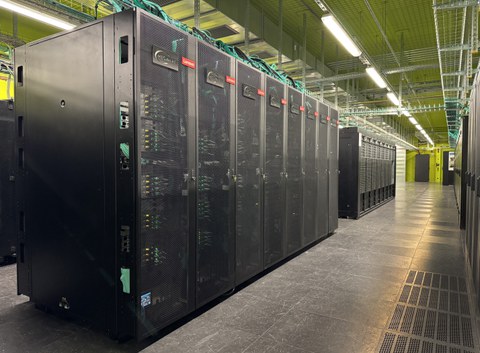Nov 22, 2024
TUD'S Capella Supercomputer ranks third most powerful Supercomputer in Germany and is fifth worldwide for energy efficiency
In the TOP500 list of the most powerful supercomputers published in November, Capella – the newly installed supercomputing system at the Center for Information Services and High Performance Computing (ZIH) at TU Dresden – has ranked 51st in the world and 3rd in Germany. In addition, Capella is setting new standards in energy efficiency, reaching 5thplace on the Green500 list, which details the most energy-efficient supercomputers worldwide. The ZIH system thus outperforms all other NVIDIA H100-based computers.
Architecture and application scenarios in research
With more than 38 Petaflops/s of high-performance computing power (number of double-precision floating-point operations performed per second), ZIH’s Capella system achieved outstanding results in November's edition of the Top500 list of the most powerful supercomputers. Installed by Megware, a company based in Saxony, and designed in close collaboration with Lenovo and others, this high-performance computer is equipped with over 140 nodes. Every node has four NVIDIA H100 accelerators and two AMD processors, each with 32 cores. In addition, each graphics processing unit (GPU) is equipped with 94 Gigabytes of high-bandwidth memory. A high-speed storage system with over 1 petabyte is used as a burst buffer and provides data to the AI accelerators at over 1500 gigabytes per second, benefiting data-intensive applications such as training large AI models. By integrating Capella into the data center's existing infrastructure, the ZIH was also able to efficiently connect the file systems of the Barnard HPC cluster in the overall complex. With its hot water cooling and use of waste heat, Capella upholds the high energy efficiency standards set by the ZIH data center.
Capella has all kinds of uses. But its combination of more than 560 high-speed AI accelerators and caches for data delivery makes Capella the ideal choice for use in artificial intelligence and data analysis, and it will be an essential tool for members of the ScaDS.AI Dresden/Leipzig AI Competence Center. The training and improvement of European language models is an important application scenario for Capella, such as in the OpenGPT-X project. Additional areas of application requiring high performance and storage volume include medical research, where, for example, machine learning methods are used for cancer diagnosis and the development of new treatments, or Earth system science, to gain new findings on natural disasters and climate change from Earth observation data.
Supercomputing at ZIH
As a National High Performance Computing Center in the National High Performance Computing (NHR) Alliance, the ZIH is tasked with providing researchers with the infrastructure, method development, and support they need to efficiently and sustainably advance breakthroughs to complex research questions in their respective fields. The ZIH places special emphasis on big data, data analytics, and AI, particularly in the life and earth system sciences. To this end, the ZIH team has been operating, developing and testing new technologies in the fields of high-performance computing (HPC), data-intensive computing and energy-efficient computing with great success for a number of years. In addition to their ongoing research into potential solutions for major HPC challenges, these efforts are closely supported by market analyses and intensive interaction with users in order to offer state-of-the-art, customized systems.
As with the previously installed clusters, the Capella components also offer exciting potential for measurements in energy efficiency research and performance optimization at the ZIH.
In addition to direct HPC support, which is available to all users, ZIH's portfolio also includes continuing education. Courses range from introductory courses to training in the use of various software tools and programming. In addition, ZIH offers first-class vocational training for IT specialists. This helps ZIH to meet future demand for support services and technical system operation.
Financing
This cluster is financed by National High Performance Computing (NHR@TUD) and the AI competence center ScaDS.AI Dresden/Leipzig – funded in equal parts by the Federal Ministry of Education and Research and the Free State of Saxony – as well as the German Center for Astrophysics.
Information on the Top500 and Green500 lists
While most of the highest-ranking computing systems worldwide are located in the United States (172), the overall ranking shows that the most powerful European supercomputers are located in Italy, Finland and Switzerland. Featuring 41 systems, Germany is ranked ahead of France (24) and the United Kingdom (14) in the list. Megware, a medium-sized company based in Chemnitz, was able to position itself well overall in the current list, with a total of eight computers at German universities, including three new systems, one of which is Capella at TU Dresden.
The Green500 list ranks the TOP500 systems according to their computational efficiency, measured in Gigaflops/Watt. This means that sheer processing power is not the deciding factor, but rather how much computational performance a system can provide per Watt of electrical power consumed. Thus, the decisive factor is the technology, rather than the size of the system.
Contact
Jacqueline Papperitz
Public Relations
CIDS – Center for Interdisciplinary Digital Sciences

